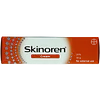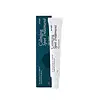What's inside
What's inside
 Key Ingredients
Key Ingredients

No key ingredients
 Benefits
Benefits

 Concerns
Concerns

 Ingredients Side-by-side
Ingredients Side-by-side

Water
Skin ConditioningPanthenol
Skin ConditioningCaprylyl Methicone
Skin ConditioningButylene Glycol
HumectantGlycerin
HumectantDicaprylyl Ether
EmollientDicaprylyl Carbonate
EmollientCetearyl Alcohol
EmollientPentylene Glycol
Skin ConditioningPolymethylsilsesquioxane
Silica
Abrasive1,2-Hexanediol
Skin ConditioningCentella Asiatica Extract
CleansingCitrus Aurantium Bergamia Fruit Oil
MaskingPelargonium Graveolens Flower Oil
MaskingSalvia Officinalis Oil
MaskingPogostemon Cablin Leaf Oil
MaskingArtemisia Vulgaris Extract
Skin ConditioningAllium Cepa Bulb Extract
Skin ConditioningArtemisia Capillaris Extract
Melaleuca Alternifolia Leaf Extract
PerfumingCynanchum Atratum Extract
Skin ConditioningCentella Asiatica Leaf Extract
Skin ConditioningGlycine Soja Oil
EmollientCetearyl Olivate
Dipentaerythrityl Hexahydroxystearate/Hexastearate/Hexarosinate
Skin ConditioningGlyceryl Stearate
EmollientSorbitan Olivate
EmulsifyingVinyldimethicone
Hydrogenated Polydecene
EmollientHydroxyethyl Acrylate/Sodium Acryloyldimethyl Taurate Copolymer
Emulsion StabilisingHydroxyacetophenone
AntioxidantPalmitic Acid
EmollientStearic Acid
CleansingDipotassium Glycyrrhizate
HumectantSodium Phytate
Tocopherol
Antioxidant4-Terpineol
MaskingCapryloyl Salicylic Acid
ExfoliatingNiacinamide
SmoothingPhytosphingosine
Skin ConditioningMaltodextrin
AbsorbentSaccharide Hydrolysate
HumectantSalicylic Acid
MaskingDimethyl Sulfone
SolventMadecassoside
AntioxidantAsiaticoside
AntioxidantEthylhexylglycerin
Skin ConditioningRetinol
Skin ConditioningLimonene
PerfumingCitronellol
PerfumingLinalool
PerfumingGeraniol
PerfumingWater, Panthenol, Caprylyl Methicone, Butylene Glycol, Glycerin, Dicaprylyl Ether, Dicaprylyl Carbonate, Cetearyl Alcohol, Pentylene Glycol, Polymethylsilsesquioxane, Silica, 1,2-Hexanediol, Centella Asiatica Extract, Citrus Aurantium Bergamia Fruit Oil, Pelargonium Graveolens Flower Oil, Salvia Officinalis Oil, Pogostemon Cablin Leaf Oil, Artemisia Vulgaris Extract, Allium Cepa Bulb Extract, Artemisia Capillaris Extract, Melaleuca Alternifolia Leaf Extract, Cynanchum Atratum Extract, Centella Asiatica Leaf Extract, Glycine Soja Oil, Cetearyl Olivate, Dipentaerythrityl Hexahydroxystearate/Hexastearate/Hexarosinate, Glyceryl Stearate, Sorbitan Olivate, Vinyldimethicone, Hydrogenated Polydecene, Hydroxyethyl Acrylate/Sodium Acryloyldimethyl Taurate Copolymer, Hydroxyacetophenone, Palmitic Acid, Stearic Acid, Dipotassium Glycyrrhizate, Sodium Phytate, Tocopherol, 4-Terpineol, Capryloyl Salicylic Acid, Niacinamide, Phytosphingosine, Maltodextrin, Saccharide Hydrolysate, Salicylic Acid, Dimethyl Sulfone, Madecassoside, Asiaticoside, Ethylhexylglycerin, Retinol, Limonene, Citronellol, Linalool, Geraniol
Ingredients Explained
These ingredients are found in both products.
Ingredients higher up in an ingredient list are typically present in a larger amount.
Glycerin is already naturally found in your skin. It helps moisturize and protect your skin.
A study from 2016 found glycerin to be more effective as a humectant than AHAs and hyaluronic acid.
As a humectant, it helps the skin stay hydrated by pulling moisture to your skin. The low molecular weight of glycerin allows it to pull moisture into the deeper layers of your skin.
Hydrated skin improves your skin barrier; Your skin barrier helps protect against irritants and bacteria.
Glycerin has also been found to have antimicrobial and antiviral properties. Due to these properties, glycerin is often used in wound and burn treatments.
In cosmetics, glycerin is usually derived from plants such as soybean or palm. However, it can also be sourced from animals, such as tallow or animal fat.
This ingredient is organic, colorless, odorless, and non-toxic.
Glycerin is the name for this ingredient in American English. British English uses Glycerol/Glycerine.
Learn more about GlycerinGlyceryl Stearate is a mix of glycerin and stearic acid.
It is used to stabilize the mixing of water and oil ingredients. By preventing these ingredients from separating, it can help elongate shelf life. It can also help thicken the product's texture.
As an emollient, it helps soften skin and supports barrier-replenishing ingredients.
In cosmetics, Glyceryl Stearate is often made from vegetable oils or synthetically produced.
This ingredient may not be fungal-acne safe
Fun fact: The human body also creates Glyceryl Stearate naturally.
Learn more about Glyceryl StearateWater. It's the most common cosmetic ingredient of all. You'll usually see it at the top of ingredient lists, meaning that it makes up the largest part of the product.
So why is it so popular? Water most often acts as a solvent - this means that it helps dissolve other ingredients into the formulation.
You'll also recognize water as that liquid we all need to stay alive. If you see this, drink a glass of water. Stay hydrated!
Learn more about Water